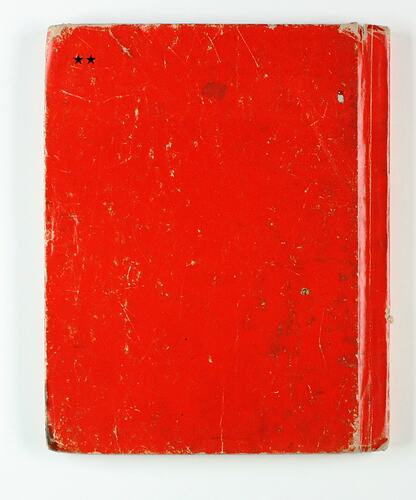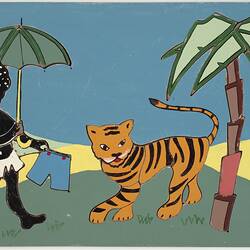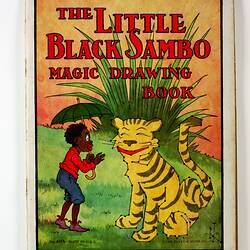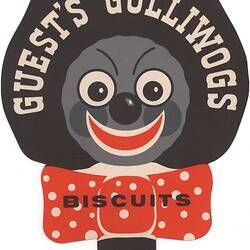Summary
Note: This object includes a derogatory slur and derogatory depiction of a particular cultural group. Such depictions are not condoned by Museums Victoria which considers them to be racist. Historical distance and context do not excuse or erase this fact.
Children's book entitled 'Little Black Sambo' published by Rand McNally & Co., Chicago, United States, published 1936. The book also contains the stories of 'The Gingerbread Man' and 'Titty Mouse and Tatty Mouse'. It consists of a story and colour illustrations.
The Story of Little Black Sambo is a children's book written and illustrated by Helen Bannerman, and first published by Grant Richards in October 1899. Sambo is a Tamil boy who encounters four hungry tigers, and surrenders his colourful new clothes, shoes, and umbrella so they will not eat him. The tigers chase each other around a tree until they are reduced to a pool of melted butter; Sambo then recovers his clothes and his mother makes pancakes with the butter. The story was a best seller until the 1930s and 1940s when the word sambo was deemed a racial slur, and the illustrations considered reminiscent of "darky iconography".
In 1942 a re-illustrated version was released in the USA, and during the mid 20th century several American editions changed the title to the racially neutral Brave Little Sambo. The book has continued to be reworked and released in 1996, illustrator Fred Marcellino produced a re-illustrated version, 'The Story of Little Babaji', which changes the characters' names but otherwise leaves the text unmodified. In 2003 a version using the original title and text with more racially sensitive illustrations was released and was chosen for the Kirkus 2003 Editor's Choice list.
Little Black Sambo books and related games were also available in Australia.
Physical Description
64 page book, black text printed on cream paper. Full colour hard cover and colour illustrations throughout.
Significance
Statement of Historical Significance:
This item is part of the Museum's collection of material which explores themes of cultural stereotyping through popular culture. It extends the collection's representation of this historically popular and serially re-invented children's story which has been the focus of controversy in the US and other countries including Australia for its cultural representations and use of the word 'sambo' now considered a racial slur.
In 1942 a re-illustrated version was released in the USA, and during the mid 20th century several American editions changed the title to the racially neutral Brave Little Sambo. The book has continued to be reworked and released in 1996, illustrator Fred Marcellino produced a re-illustrated version, 'The Story of Little Babaji', which changes the characters' names but otherwise leaves the text unmodified. In 2003 a version using the original title and text with more culturally sensitive illustrations was released and was chosen for the Kirkus 2003 Editor's Choice list.
More Information
-
Collecting Areas
-
Date Published
-
Inscriptions
Front cover: 'Little Black Sambo'
-
Classification
-
Category
-
Discipline
-
Type of item
-
Overall Dimensions - Closed
40 mm (Width), 70 mm (Height)
-
Keywords
Children's Play, Ethnic Groups, Racial Identity, Cultural Stereotypes, Racism



